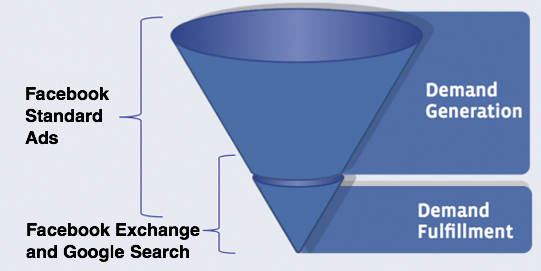Facebook Exchange could pull in a wealth of new advertising dollars by letting businesses retarget ads at Facebook users who’ve visited their websites. Now I’ve learned and confirmed that the first Exchange ads are running, and Facebook has nearly doubled the companies with access to the program. Plus one source close to Exchange tells me “initial results are good, they’re going very, very well.”
Announced 10 weeks ago, Exchange brings the first cookie-based retargeted ads to Facebook — a format common around the web but that Facebook must handle delicately because of privacy. The expansion and comments from Sheryl Sandberg show Facebook has high hopes that Exchange will bolster its bottom line.
Why Exchange Is Critical To Facebook
Here’s a quick primer on FBX. A Facebook user visits a third-party website, such as a travel site where they view prices for a hotel in Hawaii. That website drops a cookie on the user’s browser, and then hands a demand side platform (DSP) the complementary cookie. The DSP identifies the user to Facebook and tells it it wants to advertise to them the next time they visit Facebook.
The user visits Facebook, which pings the DSP asking for a real-time bid for how much they’d pay per impression to show that user a Facebook sidebar ad. If the bid is high enough, the ad gets shown, Facebook charges the DSP, and the DSP charges the website owner.

This is all so important for Facebook because it has classically been seen by advertisers as stronger for institutional brand advertising that improves awareness and perception than direct advertising whose click-throughs translate to sales.
Essentially Facebook is at the top of the funnel at demand generation, opposed to the bottom at demand fulfillment where measurement of return on investment is easier, ad rates can be higher, and Google Search rules. If Facebook wants to boost revenues and also make its ads more relevant, it needs to break into the bottom of the funnel, and retargeted Exchange ads can help.
And they are. Direct advertisers may flock to the DSPs because my source tells me Exchange results are “in-line with performance of retargeted ads [across the web] that have really high ROI. It’s going quite well.” However, there’s currently only a small volume of ads being run and I’ve heard many big travel advertisers are still getting their cookie-syncing set up to work with FBX.
New FBX Partners Signal What’s Next For Facebook Ads
On the social network’s first public earnings call a month ago, Sandberg said regarding Facebook Exchange, “We’re at a very early alpha stage test… but we’re really encouraged by how interested our advertisers and customers are.” And Sandberg’s not blowing steam. We hear AdRoll has assigned a huge chunk of its engineering resources towards working to perfect its integration with Facebook Exchange. Apparently it sees a pot of gold at the end of the rainbow if it can become the premier platform for advertisers to retarget Facebook users.
Some time between the announcement of Exchange and now, Facebook struck deals with six more DSPs to join the program. I’d learned of a few and Facebook agreed to give me the full list of Exchange partners. The newly added ones are in bold:
- AdRoll
- AppNexus
- Criteo
- DataXu
- MediaMath
- Nanigans
- Optimal
- RocketFuel
- Tellapart
- TheTradeDesk
- Triggit
- Turn
- Xaxis
- X+1
With the first wave, Facebook curiously sidestepped all its existing Ads API partners — the tools and services big businesses use to efficiently buy standard Facebook ad campaigns and Sponsored Stories. There are two possible reasons for this. First, retargeting and real-time bidding required for Exchange are specific technologies that many Ads API partners didn’t have built.
Second, and more interestingly, Facebook is not currently allowing Exchange partners to layer its standard biographical ad targeting parameters on top of retargeting. That means a DSP can’t say it only wants to target users who’ve received a cookie and are 25 to 45 year old males. This might be because Facebook refuses to give personally identifiable data on its users to advertisers. If it allowed the coupling of standard targeting and retargeting by admitting partners who do both, those ad platforms might be able to deduce characteristics of Facebook users and combine them with cookie-data to create stunningly accurate profiles of visitors to their site.
Facebook doesn’t want those DSPs to be able to turn around the Facebook bio data to improve their targeting of users outside of Facebook.com. But a different source says Facebook does want to let advertisers combine retargeting and bio data so they can serve more relevant ads on Facebook.com as long as it’s in a way that doesn’t jeopardize user privacy.

It may be setting itself up for once it’s figured out how to do that, as now Facebook has allowed Nanigans and Optim.al, two existing Ads API partners into the Exchange program. The presence of Nanigans and Optimal in the Exchange program may indicate that when Facebook is ready to combine targeting options, it wants experienced Ads API partners ready to test it. However, my sources say even if Facebook can’t securely merge the targeting options, there’s a very healthy business tapping into existing retargeted ad budgets.
So with FBX ads now running, Sandberg citing strong interest, and more partners signed on, the next step is for Facebook to prove retargeting can earn advertisers money. While the whispers I’m hearing indicate they work well, Facebook will need to compile conclusive studies demonstrating that Exchange ads sell products. Luckily, I recently came in to Facebook to talk to Sean Bruich, head of measurement and monetization analytics. He’s building up a team of specialists whose sole mission is showing advertisers that when they invest in Facebook, they get even more back.
